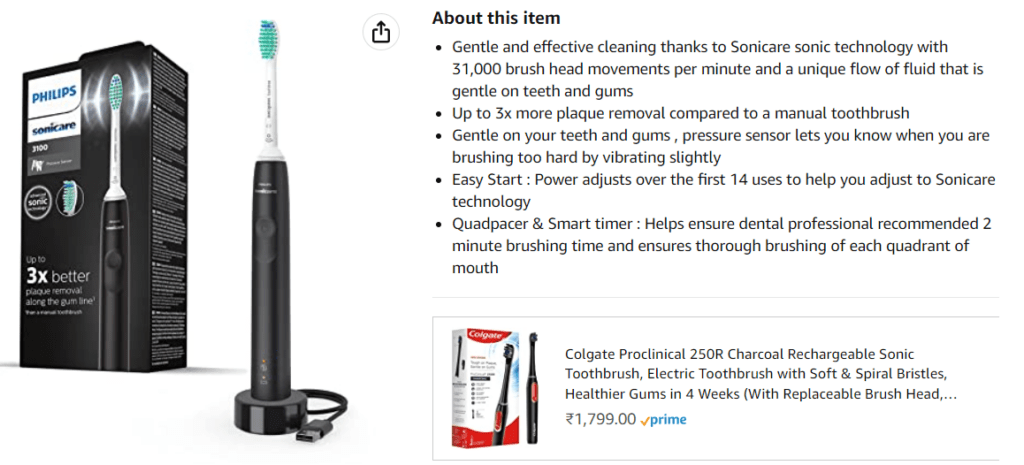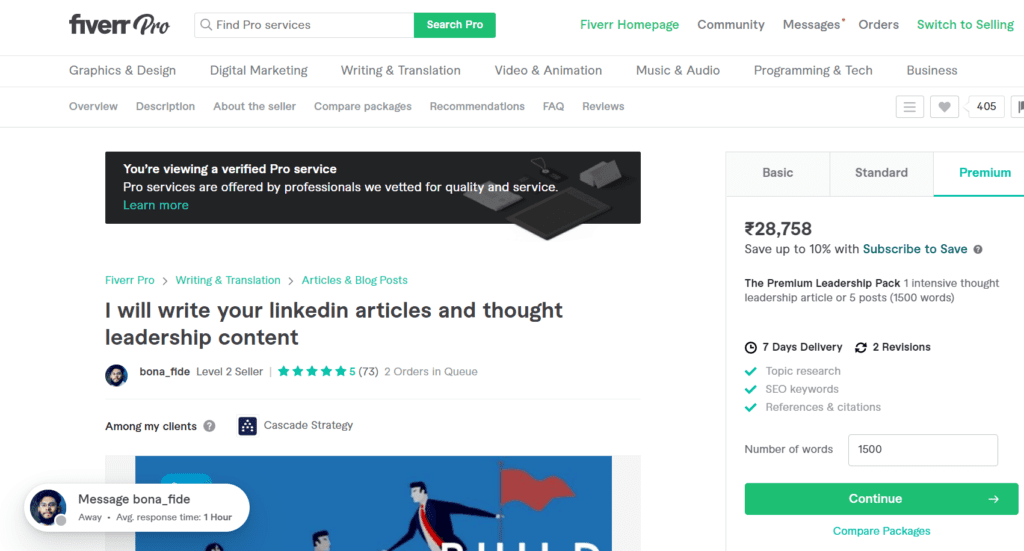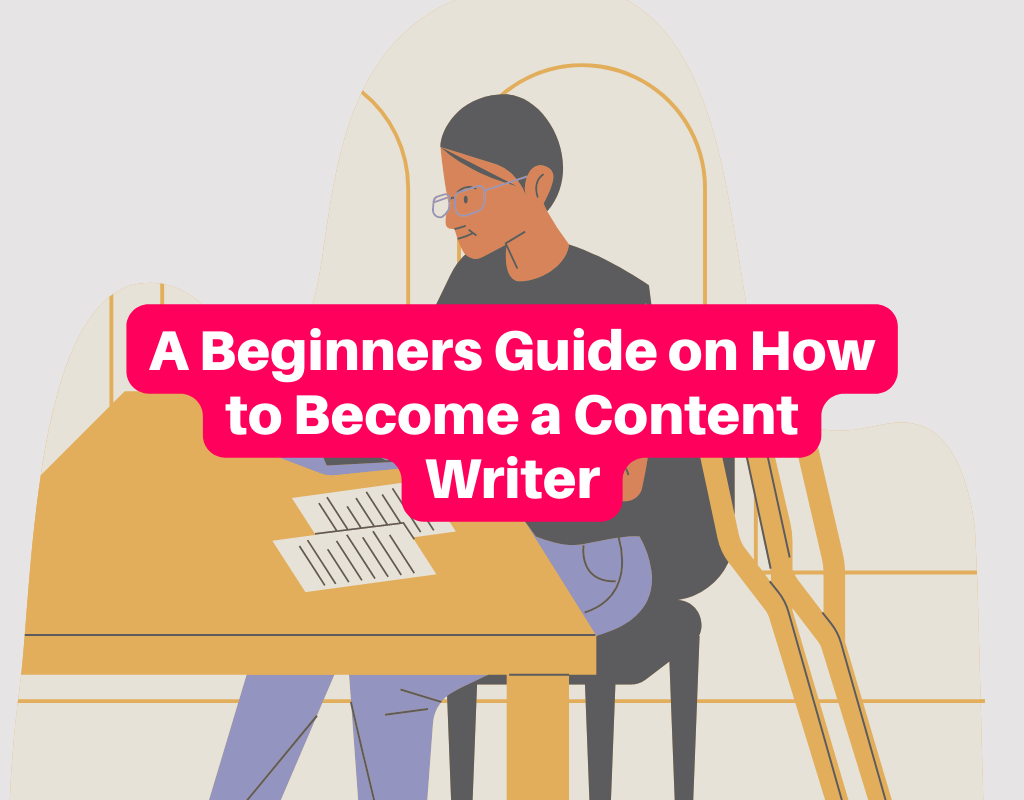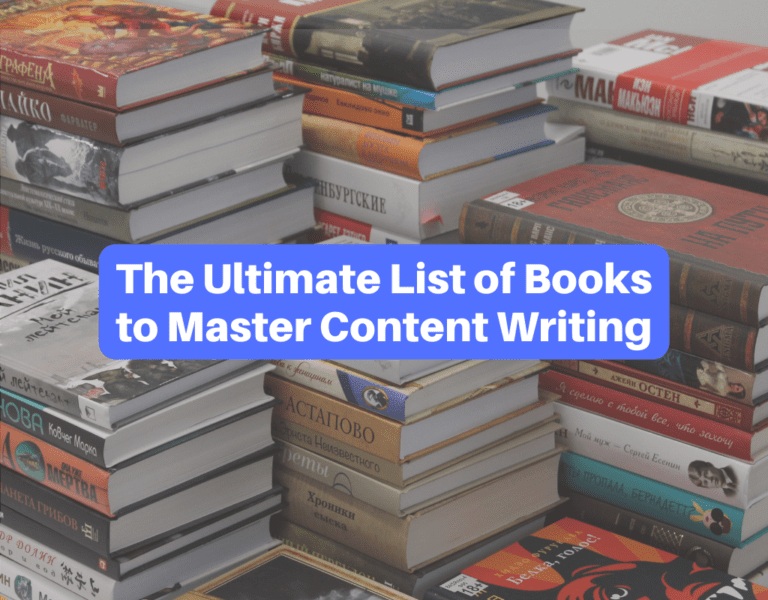Are you thinking about a career in content writing?
There are so many thing to consider: what skills should you build? How to do get a job? What does it pay?
In this post, you won’t just learn about the skills you need to become a content writer, but I’ll also give clear examples of ways to find work, build a personal brand, and earn a solid income. You’ll also get tips on freelance writing.
As you go through all the details in this post, you’ll be hooked on content writing as a career.
Let’s start with the basics!
How to become a content writer (17 critical steps for beginners)
I’ve arranged this post to give you a comprehensive understanding of content writing.
It’s an in-depth post, but you’ll come out at the end with thorough knowledge of how to become a content writer.
Step 1: Understand what content marketing is and its purpose
Content marketing is a marketing approach where you focus on creating high-quality content to achieve business goals.
It’s a long-term strategy that’s focused on providing information, building relationships, and helping businesses and professionals become thought leaders.
With content marketing, the goal is not to drive sales right away, although it is preferred.
Need an example? Check out this post by SproutSocial. Instead of creating posts promoting their tool, they’ve made one that educates people on how to grow their social media.
Why? Because this post ranks for several keywords – they get traffic organically and get buyers over the years. And it’s just one post they published a long time ago and update from time to time.
There are several things that content marketing can do for a business:
- Build a brand’s image and reputation
- Generate leads and sales
- Educate customers
- Build relationships with customers and prospects
- Increase web traffic
- Establish a website, business, or a person as an expert or thought leader
- Reduce customer acquisition costs in the long run
In fact, content marketing can do a lot more. It’s hard to track the outcomes of a good content writing strategy. Which makes it a challenging but rewarding field too.
Step 2: Determine which type of content writer you want to be
Now that you understand what content marketing is, it’s time to decide which type of content writer you want to be.
Here are the different types of writers you should know about:
Blog writers: A blog writer creates content for a specific blog.
Their job is to produce high-quality blog posts that are related to the blog’s niche.
They also need to be aware of the latest trends in their niche so they can produce content that’s relevant to their readers.
Website content writers: A website content writer produces content for specific pages on a website.
Their job is to ensure that the content on these pages is high quality, keyword-optimized, and relevant to the website’s target audience.
Social media writers: A social media writer creates content for social media platforms.
Their job is to ensure that the content is high quality, engaging, and relevant to the platform’s target audience. They also need to be aware of the latest trends so they can produce content that’s timely and relevant.
Ghostwriters: A ghostwriter is a writer who writes content for another person.
The content is published under the client’s name. Ghostwriters are often used by businesses or individuals who don’t have the time or resources to produce high-quality content themselves.
Technical writers: A technical writer creates content that is high quality, accurate, and easy to understand. They often write about complicated topics such as software, medical procedures, and industrial equipment.
As a beginner content writer, you’ll mostly write blog posts and even email content. Where there are different types of content writing, chances are that you’ll have an overlap in the skills required for each type.
The most important thing is to start writing and get experience.
Step 3: Build your knowledge and skills
No matter what type of content writing you want to pursue, there are skills that are relevant to all areas of online writing. If you want to learn content writing in general, this section will help you out.
Here are important tips and learning resources on how to become a content writer:
- Read books on content writing. The first book I read was ‘Everybody Writes’ by Ann Handley. It’s a great book for beginners.
- Do online courses on how to become a content writer. Check out affordable courses on Udemy. There are also premium sites with a higher price tag that will offer you a good learning experience.
- Read a blog post on writing every day. Check out practical tips and advice from Copywriting Course and Neil Patel.
- Listen to podcasts on writing skills and digital marketing every day. Just five minutes a day will help you develop content marketing knowledge.
In the end, learning how to write content is a matter of diving in and learning about it. And, of course, practicing how to write content.
The following steps specifically help you with real content writing skills.
Step 4: Learn to craft the perfect headline
A good writer is one who knows how to create headlines that grab attention.
Your headline (also referred to as the title) is the first thing people see when they find your content online.
If your headline isn’t interesting, no one will bother reading the rest of your article.
Here are some tips for writing headlines that get attention:
- Make your headline shorter rather than longer.
- Use numbers and statistics in your headlines.
- Use emotional words in your headlines.
- Make sure your headline is relevant to the content of your article.
- Add your keyword to the headline
Here’s a big tip for you. Use a headline analyzer tool and type in your headline.
Get a score above 70. Some good headline analyzer tools are CoSchedule Headline Analyzer and IsItWP Headline Analyzer.
Step 5: Learn to structure your posts
If you want people to read your content, you need to learn how to structure it.
The way you structure your content will make it easy or difficult for people to read.
The basic structure of any post, essay, or article includes an opening, body, and conclusion. In content writing, especially blog post writing, you must follow more best practices to create a well-structured piece.
Here are some tips on how to structure your content:
- Use short paragraphs.
- Use headlines and subheadings for different sections.
- Break up different ideas and subtopics in your post with descriptive subheadings.
- Use images, infographics, and videos across your content.
- Make sure your content is scannable by using short sentences.
- Add bullet points instead of long paragraphs.
- End your post with a strong conclusion.


Bonus tip: Use an online tool like the Hemingway app to make sure your content is easy to read.
Step 6: Find your writing voice
Your writing voice is the way you write and communicate with your audience. It’s the personality of your writing.
As a content writer, you need to find your own writing voice and use it in all your pieces.
Your writing voice will make you stand out from other writers in your niche.
To find your writing voice, ask yourself these questions:
- Who is your audience? Are they moms, athletes, students, or something else?
- What type of language do they use? Is it conversational or technical?
- What type of tone do they prefer? Do they prefer a formal or fun tone when communicating?
Your answers to these questions will help you develop your own writing voice.
Once you’ve found your writing voice, use it consistently in all your content. Including your blog, social media, landing pages, white papers, and more.
Step 7: Focus on benefits not features
This is the fundamental rule of content writing: focus on the benefits, not the features.
Your readers don’t care about your product or service, they care about how it will benefit them.
For example, if you’re selling a new type of toothbrush that is battery-operated, don’t write about the features of the toothbrush.
Instead, focus on how the toothbrush will benefit your reader.
Will it prevent the build-up of plaque? Will it save them time?
By focusing on the benefits of your product or service, you will be able to write content that resonates with your readers.


Step 8: Write as you talk
This is another important rule of content writing: write as you talk.
When many writers are getting started, they make the mistake of wanting to sound too smart. They use technical words, create long sentences, and fail to express things clearly.
Don’t try to sound like a dictionary when you write. Use your natural voice and tone.
Refer to the reader as ‘you’ in your blog posts. Get straight to the point.
The more natural and simple you sound, the more your audience will read your work.


Step 9: Use the active voice
When you use the active voice, your writing sounds more alive and interesting.
For example, which one sounds better?
‘The ball was thrown by John’. (Passive)
Or
‘John threw the ball.’ (Active)
The second sentence sounds better because it is in active voice.
Step 9: Start practicing
Now that you know the basics of content writing, it’s time to start practicing. This means creating posts for an online publication, your blog, or just on a document.
Here are a few prompts to start building your writing portfolio:
- Create a short blog post on the best places to eat in your city. Make it 500 words.
- For your next attempt, make the post longer, detailed, and add pictures.
- For a third attempt, focus on a single place in your city and write a piece so compelling that people want to head to the place
- Repeat steps 1-3 on different topics.
Whether you want to become a freelance writer or work as a content creator in a business, you need to have worked on a few pieces of content. For now, just practice as much as you can and get comfortable with the act of writing.
Step 10: Create a writing portfolio
When you apply for a job as a content writer or try to establish yourself as a freelance writer, you need a writing portfolio to showcase your work.
A portfolio is a body of work that showcases your best work. It acts as proof that you’re skilled. You can share it with clients and hiring personnel to show them your writing samples.
When you apply for work, a hiring company will give you a topic and ask you to submit content. In some cases, a portfolio will make it unnecessary for you to create content from scratch just to go to the next round of a hiring process.
There are a few ways freelance writers and content writers can build a writing portfolio:
- Use a specialized tool like Clippings.me or About.me to add articles and blogs and share them with the world
- Build your own blog and add links to your existing online content
- Create posts on Medium, LinkedIn, Vocal.media, and other websites and share these links
- Create a document including links to all your written and published work
These are a few ways to show clients and businesses examples of your content.


The key is to make it easy for people to browse your work and learn what they need to about you.
Step 11: Leverage content writing tools
There are a number of content writing tools that can help you write better content.
Here are some of our favorites:
- Grammarly: This tool helps you find and correct grammar mistakes in your writing.
- Hemingway App: This tool makes your writing more clear and concise.
- Google Docs: This tool is critical because you can write directly on it. More importantly, you can edit and collaborate with it in real-time.
- WordPress – This is a popular content management system that helps you easily create and manage your content.
- Copyscape: This tool helps you find and correct plagiarism in your writing.
- SurferSEO: Use this tool to optimize your blog posts for a specific keyword. It will help you rank higher on search engines for key terms.
- SEOmoz: This tool helps you optimize your content for search engines.
- Google Analytics: This tool helps you track your content’s performance and see how people are interacting with it.
These writing apps or tools are essential if you want to make your posts target a specific audience. Or if you want to optimize your blog posts and articles for search engines.
Step 10: Join writing platforms
There are several free writing platforms that you can join to get more practice writing.
These platforms are a great way to get feedback on your writing from other writers. You’ll build your reputation as a writer and develop an online presence. So that when people search for you online, your name and work shows up automatically.
Here are a few popular writing platforms to join:
- Medium
- Quora
- Vocal.media
- WordPress.com
- Blogger.com
Joining a writing platform is important because you can start to publish your work and build your online presence as a content writer.
These platforms will also give you an idea of what type of content is popular, and what people are looking for when they read online.
By understanding these things, you can start to write content that people want to read.
Step 11. Start publishing your work
Once you’ve written a few pieces of content, it’s time to start publishing your work.
The best way to do this is to create your own website or blog. This will be a place where you can publish all your writing and build a following of readers.
However, if you don’t want to set up a website, just write on the platforms mentioned in the last section.
The important thing is to establish yourself as a content writer and to start sharing your work with the world.
Step 12: Update your LinkedIn profile
If you want to get hired as a content writer, you need to have an up-to-date LinkedIn profile.
This type of profile is like your online resume. It’s where potential clients and employers will go to learn more about you and your work.
Make sure to include your experience as a content writer everywhere on your profile. Even if you’ve only been learning about content writing for a few weeks or months, it’s worth adding to your list of experiences.
If you want to work full-time in a company or be a freelance writer, it’s important to update your profile to say that you’re ‘Open to Work’.
It’s where LinkedIn shows up your profile when people look for specific keywords.
For example, if someone searches for ‘content writer’, your profile will show up in the search results. Also, mention a niche if you’re focused on one. People look for specialists in writing niches on LinkedIn. You’ll be found more easily.
Step 13: Create a resume focused on content writing
If you want to get hired as a content writer, you need to have a resume that focuses on your content writing experience.
Freelance writers can also benefit from creating a content writing resume. You never know when you’ll need it.
Keep your resume simple and well-organized. Make sure to list any relevant experiences you have, such as blogging, copywriting, or editing.
I suggest adding a writing niche to your resume. This could be ‘SEO copywriting’ or ‘B2B content writing’.
And if you don’t have any content writing experience, that’s okay. Just focus on any other writing experiences you have, such as academic essays or short stories.
The important thing is to make sure your resume is tailored to content writing.
Step 14: Start applying for content writing jobs
Now that you have a few pieces of writing to show off, it’s time to start applying for content writing jobs.
There are a few ways to find content writing jobs:
- Online job boards. For example: Indeed, LinkedIn, Glassdoor, and others
- Reach out to companies directly and inquire about content writing positions
- Let your friends and family know that you’re looking for a content writing job
- Create posts on social media saying you’re available to work and use relevant hashtags


It will take time but eventually, with enough perseverance, you’ll find a content writing job that’s right for you.
Step 15: Sign up to work on freelancing platforms
If you don’t want to commit to a full-time content writing job, you can start freelancing instead.
It’s a good idea to sign up on freelancing sites even if you want a full-time job so that you can work during times when you’re looking for work.
Freelancing platforms let you work on a per-project basis, which gives you more flexibility.
The downside is that you won’t have a regular income, and you’ll have to find your own projects.
The upside is that you can work from anywhere, and you can set your own rates.
There are a few freelancing platforms you can sign up for, such as:
- Upwork
- Fiverr
- PeoplePerHour
- Toptal
- Guru
- Contentmart.com
Just create a profile and start applying for writing projects. You can also reach out to businesses directly and inquire about writing projects.
The important thing is to get started, feature a few writing samples, and actively seek content writing opportunities.


When you apply for a project or job, make sure you personalize your proposal. You’ll increase the chances of winning a freelance writing project.
Step 16: Network with other content writers
A key part of being a content writer is networking with other content writers.
You can learn a lot from other writers, and it’s also a great way to find clients and get work.
You’ll also add to your reputation when you connect and engage with more established people in the field.
Finding writing groups on Facebook and Reddit. Follow content writers on Twitter and Instagram. And then reach out to them.


Just leave a comment on their posts or have a casual conversation with them. As you build a relationship, you’ll get new ideas, tips, and even work opportunities.
Step 17: Build your personal brand
And finally, one of the most important things you can do as a content writer is to build your personal brand.
Your personal brand is what makes you unique and different from other writers.
Here are a few ways to build your personal brand:
- Turn your name into a calligraphy-style logo
- Use a set of colors as your brand palette. Apply this color palette in all your communication.
- Build a website and share content
- Use guest posting on other sites to grow your reputation
- Be active on social media and share unique and thought-provoking content
- Provide value
Over time, you’ll build a reputation and a brand as a stand-out content writer. You’ll find it easier to stand out amongst other candidates and can charge more for your freelance writing services.
Content writing is a great way to make a living. It’s a flexible job that you can do from anywhere. If you follow the steps given in this post, you’ll soon be on your way to becoming a content writer.
What qualifications do you need to be a content writer?
There are no specific qualifications you need to be a content writer. However, having a degree in English, journalism, or communications can be helpful.
If you have a background in marketing, business, or a related field, that’s useful too. Remember, you’re involved in marketing – it’s just that you’re writing to achieve a business’s goals.
The important thing is to have strong writing skills and be able to produce quality content. You need to have soft skills like being able to communicate well, being organized, and being able to work well with others.
You also need to be proactive and have a positive attitude.
How much does a content writer earn?
So, you’ve looked at a number of steps to help you get into the writing business, whether it’s as an employed content writer or a freelance writer.
But is it worth it in terms of making money? Let’s see.
There’s no easy answer to this question. Here’s what you find when you do your research:
- How much a beginner content writer makes in USA: $57,597 a year (median, Talent)
- How much beginner content writers make in India: $1533 a year (average, AmbitionBox)
As you can see, a significant part of how much you earn depends on where you live.
However, as you grow your skills and get experience, your earning potential grows. You can also upgrade to becoming a content marketing manager if you’re done focusing on writing.
When you work as a freelance writer, it can go either way – you can make well above average or struggle to earn a basic income.
A lot depends on how well you market yourself, the state of the economy, and your skills. And not just how well you write, but also other skills like researching, negotiation, pricing, etc.
My best advice is to specialize in some areas – especially related to technology. If you can work as a niche writer, you get a higher pay per word. And you’ll be more in demand in your industry.
However, you can earn a 6-figure income in the following ways:
- Start a content agency and find high paying clients
- Create a blog, build traffic, and create an income through ads, affiliate marketing, and sponsored content
- Get a degree in a specialized skill – think data analytics, biotech, or something else and market yourself as a niche writer
It’s not easy to get started. But as you push towards a higher-income, you’ll gradually get there.
Everything you need on how to become a content writer
There are many plusses and minuses to working as a content writer or a freelance writer.
For one thing, it’s a flexible job that you can do from anywhere. And there’s always going to be a demand for good content.
But it’s not a get-rich-quick scheme. You need to have strong writing skills and be able to produce quality content consistently.
You also need to be proactive and have a positive attitude. Marketing yourself well is essential if you’re going to be a successful freelance writer.
If you’re thinking of becoming a content writer, I hope this post has given you some helpful tips on how to get started.







